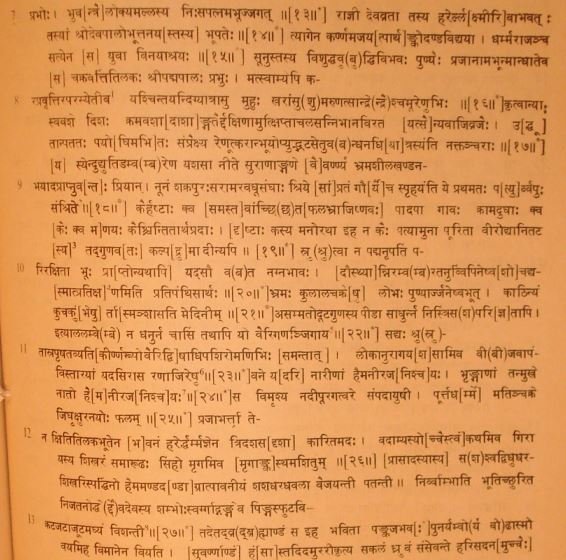|
INSCRIPTIONS OF THE CHANDELLAS OF JEJAKABHUKTI
GWĀLIOR STONE INSCRIPTION OF MAHĪPĀLA

_________________________
1 There is a play on the word kara which means (1) a ray and (2) a tax.
2 As suggested by Kielhorn, Śrī (majesty) and Gaurī (the earth) are represented as the wives of the king.
3 Read
4 This letter is damaged and the reading is conjectural. In the following verse the figure of speech is Parisaṅkhyā, examples of which are often found in the Kādambarī . Nagna in the present case means
‘a chāraṇa’. For a similar expression, cf. Kuvindas tvaṁ tāvat, in Kāvya-Prakāśa, VII.
5 This verse has the double entendre with a play on the use of guṇa meaning (1) virtue and (2) bowstring ; and nistṛiṁśa meaning (1) merciless and (2) sword.
6 For grammatical construction, cf. prabhraṁśayāṁ yō nahushaṁ chakāra, in Raghuvaṁśa, XIII, 36.
7 For Kielhorn’s translation of this verse, see op. cit., p. 43 and n. 122. Differing from him, I take it to
mean that “the wives of his enemies residing in the bees looking to their faces, could not decide whether
the forest take one night of the Hēmanta season as many (haimanī-rajanī-chaya) ; and consequently,
they were really gold-lotuses (as the faces were pale in consequence of the separation from their husbands).
8 Kielhorn translates this as “from the top of the golden staff…” But a n is clear enough before the
following da, and thus the expression would mean “falling on the golden jar from the tip of the staff”.
Kielhorn also takes maṇḍa in the sense of ‘ornamental’ : but in that case the simile would not be
complete and where the banner was falling is also not known. My interpretation of the expression
(with the reading aṇḍam) compares the banner to the Ganges, falling from the staff (As from the sky) on
the matted hair of Śambhu. The word aṇḍa here to be taken in the sense of aṇḍāḳāra-kalaśa. cf. turastvaṁḍaṁ nigaditaṁ Agni-Purāṇa, 61. v. 23.
|